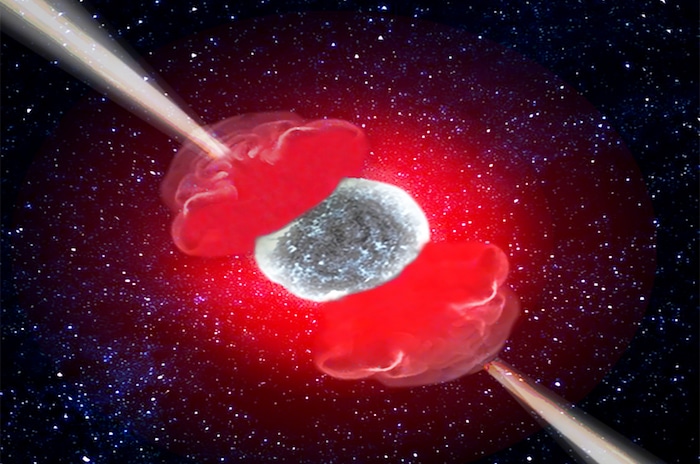Jan 18 2019
The most powerful explosions in the universe are gamma-ray bursts (GRBs), which last several seconds and emit the amount of light analogous to almost all the stars in the cosmos.
 Artist representation of the hypernova. (Image credit: Anna Serena Esposito)
Artist representation of the hypernova. (Image credit: Anna Serena Esposito)
Only during catastrophic events such as the death of an enormous star are such excessive amounts of energy liberated, producing visible hypernovae or supernovae, where the former is 5 to 50 times more energetic compared to the latter.
Although the relation between hypernovae and GRBs has been established well, it is still obscure why certain hypernovae lack associated GRBs. An international group of scientists, including Chryssa Kouveliotou, a professor of physics at the George Washington University, performed detailed observation of a rare, nearby hypernova and found out the missing relation between GRBs and hypernovae, which is a hot cocoon surrounding the streams of matter discharged by the central engine when these are spread through the outer layers of the progenitor star.
For a handful of hypernovae not accompanied by GRBs, an excess of high velocity material had been observed in their optical spectra, which had been attributed to a thermal cocoon, namely a jet which never managed to break out of the interior to the surface of its progenitor star. With this recent event, we showed the jet provided a significant part of its energy to the cocoon, which allowed both the jet and the gamma rays to break out of the surface of the star. This was the first time we actually got to peek directly at the core of a collapsing massive star!
Dr Chryssa Kouveliotou, Professor of Physics, George Washington University
The new finding has been described in the study titled “Signatures of a jet cocoon in early spectra of a supernova associated with a γ-ray burst,” published in the Nature journal on January 17th, 2019. The international group was headed by Luca Izzo, a researcher at the Institute of Astrophysics of Andalusia in Spain. Dr Kouveliotou was one of two researchers on the group based in the United States.
In a spiral galaxy located nearly 500 million light-years from Earth, the scientists discovered a long-duration GRB on December 5th, 2017. This was the fourth closest long-duration GRB to be ever observed. Due to the fact that this GRB, designated 171205A, was very close to Earth and spotted very early, the researchers could monitor the evolution of the source every day with the largest telescopes across the globe. This collective work enables scientists to capture a remarkable level of information related to the event in various different wavelengths over time.
In the first few days following the GRB detection, although the researchers reported evidence of the existence of a hypernova, the findings were very strange. Hypernovae exhibit high expansion velocities of about 30,000 km/second; by contrast, the velocity of the hypernova observed by the researchers—labeled SN 2017iuk—was considerably higher, over 100,000 km/second in the first few hours following the explosion. A thorough analysis of the multi-wavelength emission noted in the first few days of SN 2017iuk brought about astonishing results.
We first noticed a peculiar component, which showed very high velocity and unusual chemical composition not seen previously in similar events. These features fit perfectly with the assumption that we observe material from the central engine escaping from the GRB progenitor star.
Dr Chryssa Kouveliotou, Professor of Physics, George Washington University
In fact, the researchers were able to observe a hot cocoon absorbing material from the star’s interior and passing it to the outer layers. After nearly three days, once the hot cocoon faded away, the hypernova started acting similar to those observed earlier. The scientists pointed to the fact that the energy liberated by the cocoon in the earliest days of the hypernova was more than that of the GRB, suggesting the jet deposited a huge portion of its energy into the cocoon. These outcomes show that choked jets are in fact the reason why certain hypernovae do not appear to be linked with GRBs.
The scientists remarked that the findings have intriguing consequences for the way in which hypernova and supernova explosion models are constructed in the future.